
Robert Adam was a British neoclassical architect, interior designer and furniture designer. He was the son of William Adam (1689–1748), Scotland's foremost architect of the time, and trained under him. With his older brother John, Robert took on the family business, which included lucrative work for the Board of Ordnance, after William's death.

The City Hall, Dublin, originally the Royal Exchange, is a civic building in Dublin, Ireland. It was built between 1769 and 1779, to the designs of architect Thomas Cooley, and is a notable example of 18th-century architecture in the city. Originally used by the merchants of the city, it is today the formal seat of Dublin City Council.

The Pantheon is a former Roman temple and, since AD 609, a Catholic church in Rome, Italy. It was built on the site of an earlier temple commissioned by Marcus Agrippa during the reign of Augustus, then after that burnt down, the present building was ordered by the emperor Hadrian and probably dedicated c. AD 126. Its date of construction is uncertain, because Hadrian chose not to inscribe the new temple but rather to retain the inscription of Agrippa's older temple.

James Wyatt was an English architect, a rival of Robert Adam in the neoclassical and neo-Gothic styles. He was elected to the Royal Academy of Arts in 1785 and was its president from 1805 to 1806.
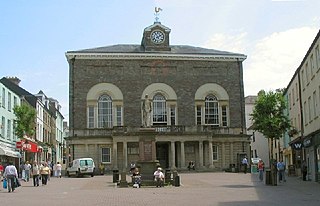
Sir Robert Taylor (1714–1788) was an English architect and sculptor who worked in London and the south of England.

A rotunda is any roofed building with a circular ground plan, and sometimes covered by a dome. It may also refer to a round room within a building. The Pantheon, Rome, is the most famous and influential rotunda. A band rotunda is a circular bandstand, usually with a dome.

The Rotunda is a building located on The Lawn on the original grounds of the University of Virginia. Thomas Jefferson designed it to represent the "authority of nature and power of reason" and modeled it after the Pantheon in Rome. Construction began in 1822 and was completed shortly after Jefferson's death in 1826. The campus of the new university was unique in that its buildings surrounded a library rather than a church, as was common at other universities in the English-speaking world. To many, the Rotunda symbolizes Jefferson's belief in the separation of church and education, and represents his lifelong dedication to education and architecture. The Rotunda was designated a National Historic Landmark in 1966, and is part of the University of Virginia Historic District, designated in 1971.

The Russell Senate Office Building is the oldest of the United States Senate office buildings. Designed in the Beaux-Arts architectural style, it was built from 1903 to 1908 and opened in 1909. It was named for former Senator Richard Russell Jr. from Georgia in 1972. It occupies a site north of the Capitol bounded by Constitution Avenue, First Street, Delaware Avenue, and C Street N.E.
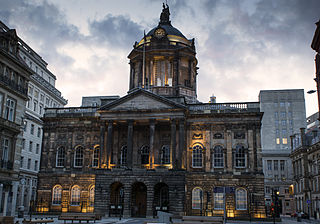
Liverpool Town Hall stands in High Street at its junction with Dale Street, Castle Street, and Water Street in Liverpool, Merseyside, England. It is recorded in the National Heritage List for England as a designated Grade I listed building, and described in the list as "one of the finest surviving 18th-century town halls". The authors of the Buildings of England series refer to its "magnificent scale", and consider it to be "probably the grandest ...suite of civic rooms in the country", and "an outstanding and complete example of late Georgian decoration".

Almack's was the name of a number of establishments and social clubs in London between the 18th and 20th centuries. Two of the social clubs would go on to fame as Brooks's and Boodle's. Almack's most famous establishment was based in assembly rooms on King Street, St James's, and was one of a limited number of upper-class mixed-sex public social venues in the British capital in an era when the most important venues for the hectic social season were the grand houses of the aristocracy. The site of the club, Almack's Assembly Rooms or Willis's Rooms, has become retrospectively interchangeable with the club, though for much of the club's lifetime, the rooms offered a variety of other entertainments with no connection to the club.
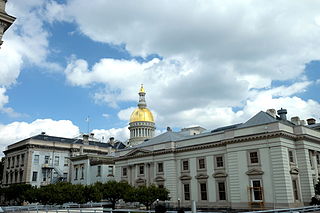
The New Jersey State House is the capitol building of the U.S. state of New Jersey and is the third-oldest state house in continuous legislative use in the United States. Located in Trenton, it was originally built in 1792 and is notable for its close proximity to the state border with Pennsylvania, which makes it the closest capitol building to a state border. The building accommodates both the New Jersey Legislature's Senate and General Assembly chambers, offices of the Governor, Lieutenant Governor, and various state government departments.
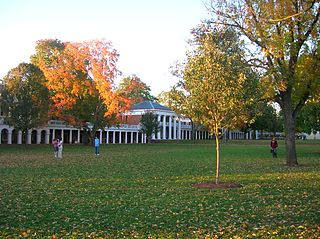
The Lawn, a part of Thomas Jefferson's Academical Village, is a large, terraced grassy court at the historic center of Jefferson's academic community at the University of Virginia. The Lawn and its surrounding buildings, designed by Jefferson, demonstrate Jefferson's mastery of Palladian and Neoclassical architecture, and the site has been recognized as an architectural masterpiece in itself. The Lawn has been designated a U.S. National Historic Landmark District, and is part of a UNESCO World Heritage Site along with the original buildings of the University of Virginia and Monticello, Jefferson's nearby residence; this designation is due to the site's architectural and cultural significance.

The Bath Assembly Rooms, designed by John Wood the Younger in 1769, are a set of assembly rooms located in the heart of the World Heritage City of Bath in England which are now open to the public as a visitor attraction. They are designated as a Grade I listed building.

In Great Britain and Ireland, especially in the 18th and 19th centuries, assembly rooms were gathering places for members of the higher social classes open to members of both sexes. At that time most entertaining was done at home and there were few public places of entertainment open to both sexes besides theatres. Upper class men had more options, including coffee houses and later gentlemen's clubs.
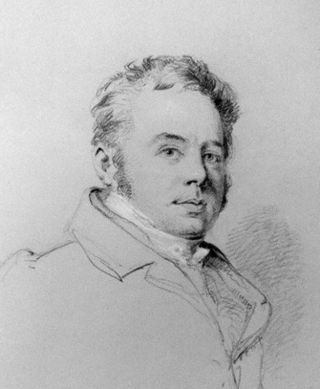
John Buonarotti Papworth was a British architect, artist and a founder member of the Royal Institute of British Architects.

The United States Capitol features a dome situated above its rotunda. The dome is 288 feet (88 m) in height and 96 feet (29 m) in diameter. Designed by Thomas U. Walter, the fourth Architect of the Capitol, it was constructed between 1855 and 1866 at a cost of $1,047,291.

The William A. Clark House, nicknamed "Clark's Folly", was a mansion located at 962 Fifth Avenue on the northeast corner of its intersection with East 77th Street on the Upper East Side of Manhattan, New York City. It was demolished in 1927 and replaced with a luxury apartment building.

The École de Chirurgie is a historic building located at 10–12 rue de l'École de Médecine in the 6th arrondissement of Paris. Today it is the headquarters of the Paris Descartes University.

Montpellier Rotunda is a Grade I listed building in Montpellier, Cheltenham, England.
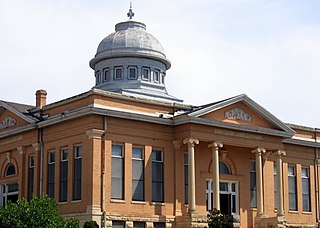
The Carnegie Library in Guthrie, Oklahoma, is a building at 406 East Oklahoma Avenue. Constructed in 1901, It was the second Carnegie-funded library built in Oklahoma and the oldest one still in existence. The Guthrie library opened on May 20, 1903, It remained Guthrie's main library until 1972, when the city decided to tear it down and build a new facility in its place. Fred Pfeiffer, a local philanthropist, offered to fund a new structure next door to the Carnegie Library, if the old building were kept intact. The city accepted his offer, and gave the building to the Oklahoma Historical Society. It was listed on the National Register of Historic Places in 1971. The old building is now part of the Oklahoma Territorial Museum. Oklahoma Territorial Museum opened Nov. 13, 1973.

























